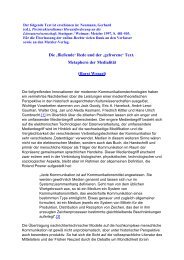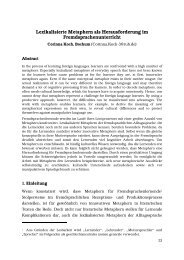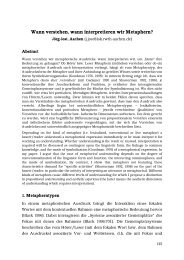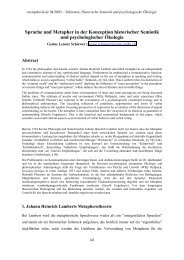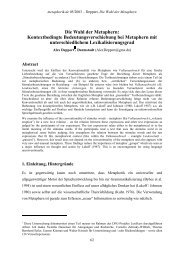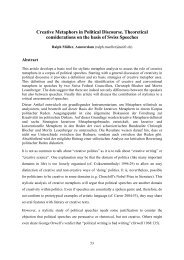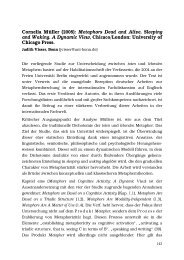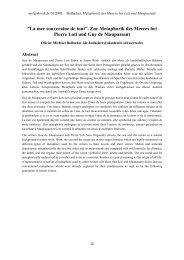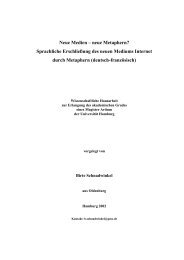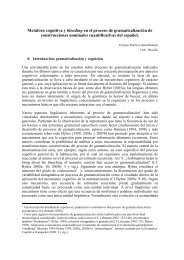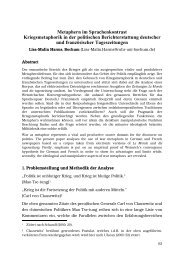The Sweet Smell of Red - An Interplay of ... - metaphorik.de
The Sweet Smell of Red - An Interplay of ... - metaphorik.de
The Sweet Smell of Red - An Interplay of ... - metaphorik.de
You also want an ePaper? Increase the reach of your titles
YUMPU automatically turns print PDFs into web optimized ePapers that Google loves.
88<br />
<strong>metaphorik</strong>.<strong>de</strong> 18/2010<br />
find many synaesthetic metaphors with smell or smell related words either.<br />
This however, is not the case. <strong>The</strong> outcome <strong>of</strong> my analysis showed clearly that<br />
smell is actually the second most <strong>of</strong>ten used sense in the target domain with 55<br />
occurrences and can also occur in the source domain. This is an amazing<br />
finding taking into consi<strong>de</strong>ration that there are so few olfactory words and<br />
those are not very broad in their concept. Especially with taste a strong linkage<br />
can be discovered to smell, although this link seems to work in one way only,<br />
since taste with smell in the source domain did not occur at all. In all my<br />
examples including all the senses, taste could generally not be found. <strong>The</strong><br />
sense that occurs in third most position as the target domain is vision with 47<br />
occurrences. Its most frequent combination is touch with which it co-occurs in<br />
34 cases. Both other senses – touch and taste – are not very productive as<br />
target domain, but show the highest frequencies in the source domain, which<br />
also conforms to Ullmann's claim (1964). Hence, it can be seen that there are<br />
very obvious ten<strong>de</strong>ncies in the make-up <strong>of</strong> synaesthetic metaphors.<br />
It is amazing that these ten<strong>de</strong>ncies that have been discovered before, are really<br />
valid since Ullmann for example, never explains how he gets his results, it<br />
might just be that they were mostly based on intuition.<br />
<strong>The</strong> assumption <strong>of</strong> easier comprehension <strong>of</strong> metaphors that combine terms<br />
from rather closely related senses is difficult. Of course it can be found that<br />
taste and smell are highly productive together, but only in the direction taste<br />
(source domain) – smell (target domain). Thus, there seems to be a certain<br />
directionality un<strong>de</strong>rlying the possible combinations. Ullmann (1964) claims<br />
that this directionality goes from the lower senses to the higher senses. In<br />
other words, the lower senses (touch, taste) occur mostly in the source domain,<br />
while the higher senses (hearing, vision) are used for the target domain. This<br />
cannot be verified in my analysis, although the general ten<strong>de</strong>ncy for touch and<br />
taste in the source domain can be observed. According to Classen (1993) terms<br />
relating to hearing are too specific to be used metaphorically at all, this does<br />
not agree with my results either, since in both languages smell occurred even<br />
less <strong>of</strong>ten in the position <strong>of</strong> the source domain and even though only five<br />
examples could be found with hearing altogether, it is obvious that they can<br />
occur and can be comprehen<strong>de</strong>d.



